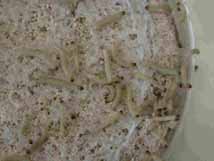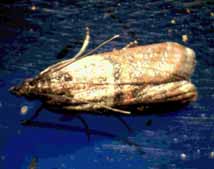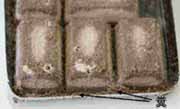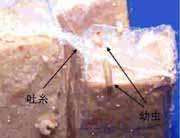- Yokohama-shi Top Page
- Health, Medical and Welfare
- Health and Medical Care
- institute for health
- Living Environment Hygiene Information
- Information on pests
- Is it okay to manage food? (Part 1 Nosimame Madara Meiga)
Here's the text.
Is it okay to manage food? (Part 1 Nosimame Madara Meiga)
Last Updated April 1, 2023

Larvae of Noshimemadalamiga
- Have you ever seen milky white beetle-shaped insects in or around the container where the food was stored, on shelves, etc.?
- Have you ever seen a small moth flying around in the kitchen or living room?
The larvae are small and have a body length of about 2-3 mm and are pale pink or orange. When it is slightly larger, the color is white and the size is about 13mm. Adults are about 13mm, and fold their wings into a roof shape to stay still. When stationed, the first half of the feathers are gray-brown, and the second half is red-brown.

An adult of Noshimemadalamiga
The first thing to be questioned is Noshimedarameiga. This insect is a typical food pest.
- Are the flour, hot cake ingredients and powdered soup all right now?
- What kind of chocolate and bean confectioneries are you eating?
It is only during the larvae that noshimedamameiga harms food. Adults do nothing. However, he is good at finding a place where food is located and lays a number of small white eggs around cans and bottles containing food. The larva returned from the egg finds a small gap, enters the container, and reaches the food. Even if you are secure with solid packaging, small larvae can break through the packaging paper with strong chins and invade. Once invaded, the food feeds on larvae and loses its value as food.
Foods that have been damaged by Noshimemadarameiga have a characteristic rest. Once carefully check the food and storage container.
- Do you have a lot of small orange granules inside food or storage containers?
- Do you see a white thread like a spider web inside or on the lid of the food or storage container?

Feces

Larvae and spine
If the above features are found, there is no mistake in first doubt of Noshimemadarameiga.
This insect damages a lot of dried and processed foods.
For example, cereals (rice, wheat, etc.), powders (wheat flour, hot cake ingredients, etc.), dried fruits, sweets (bean confectionery, chocolate, cookies, etc.), nuts, etc.
[Storage is in a container with a packing! ]
Even unopened food is not enough by packaging alone. You may get rid of it. Store in a container that can be tightly sealed.
In addition to this Noshime Madara Meiga, there are many insects and ticks that harm food.
Be very careful when storing and storing food.
[If you think it is doubtful]
It is very difficult to identify insects. If you are in doubt, bring an insect to a nearby Health and Welfare Center and consult.
(Explanation of Noshime Madarameiga in the text)
Noshimemadarameiga Plodia interpunctella
Adults are 13-16mm long. Half near the base of the front wing is gray to grayish white, and the outer half is reddish brown. The feature is that when viewed from above when it stands still, the forehead looks protruding like a conical shape. The lifespan of adults is about one week.
The larvae are sloppy cylindrical, and the mature larvae are about 10 mm long. The body color is pale milky white. Under the natural conditions of Japan, it is possible to grow except in winter.
Graces, grains, dried fruits, and confectioneries. It is widely distributed in Japan.
Inquiries to this page
Microbial Inspection and Research Division, Medical Care Bureau Institute of Health
Telephone: 045-370-9379
Telephone: 045-370-9379
Fax: 045-370-8462
Email address: ir-eiken@city.yokohama.jp
Page ID: 150-677-377







